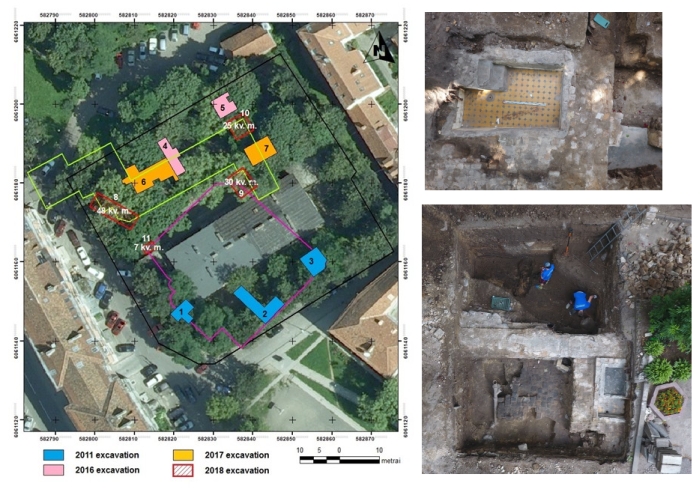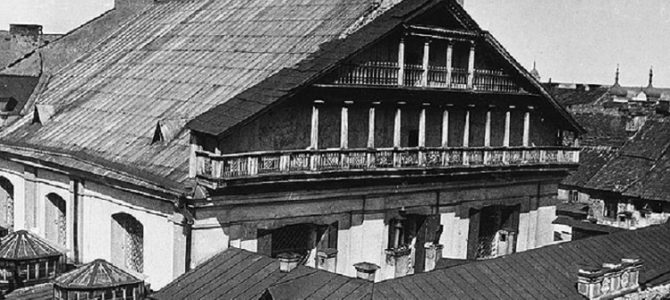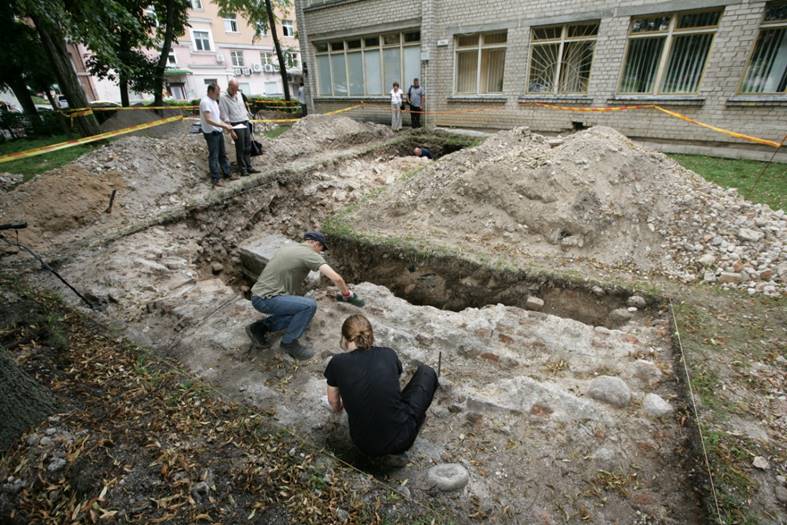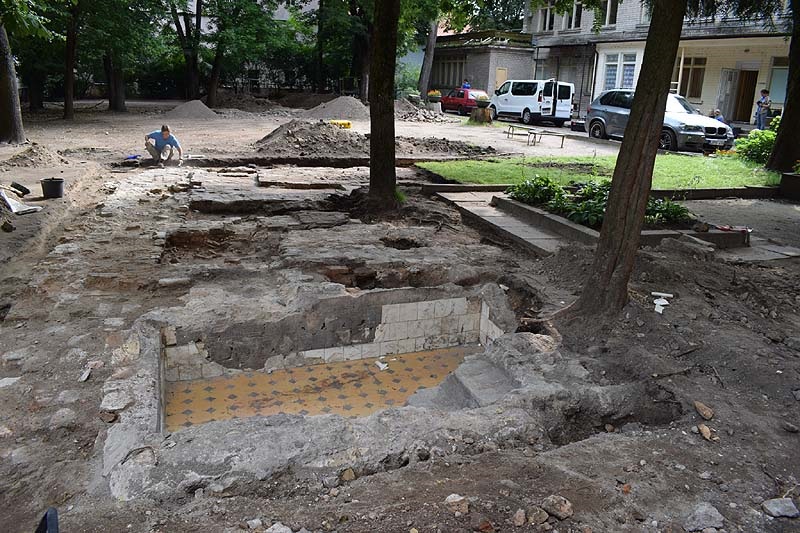
Dr. Jon Seligman of the Israeli Antiquities Authority has announced excavation of the Great Synagogue and the former complex of surrounding buildings known as the Shulhoyf in Vilnius will resume this summer July 9 and will continue till July 27. Those interested in volunteering should contact Dr. Seligman, address below.
The Great Synagogue and Shulhoyf of Vilna (Vilnius): The 2018 Season
A Research, Excavation, Preservation and Memorial Project
A Quick Summary of the Work until Now
The successful outcome of the preliminary excavation of 2011, the 2015 ground-penetrating radar survey and the 2016 excavation showed us the potential of continued excavation at the site to uncover further sections of the Great Synagogue and the surrounding buildings. Given the resources available to the team, we decided to initially concentrate on issues relating to the water system of the shulhoyf that developed in and around the Great Synagogue in the 18thcentury. Written sources inform us that a pipeline was established in 1759 to bring water from the Vingrių springs, that belonged to the Dominican friars, to the synagogue complex. It supplied water to the communal “well,” and apparently to the bathhouse constructed between 1823 and 1828 that included a miqve and a public lavatory.
In 2016 a plan, dated to the end of the 19th century, for the reconstruction of the bathhouse was found in the city archives in Vilnius, shows that the bathhouse consisted of two main floors. Detailed analysis of the plan showed the building to consist of two large latrines, various rooms and two interesting rooms – number 9 and 16 on the plan. These rooms had a large heating stoves and what seems to indicate a stepped pool, in our opinion the miqve, a fact that only excavation can verify. It was decided to excavate two small areas directly over these locations, with the hope that the plan would match the reality in the field and that we would be able to uncover the two ritual baths (miqve’ot) of the Jewish community.
During the excavation both miqva’ot were exposed. The first miqve, in the SW of the bathhouse, was excavated in its entirety. This consisted of an almost rectangular bath that belonged to the latest renovation of the bathhouse, probably dated to 1881 or in the following few years. In the SW corner of the installation were the remains of steps, two of which are complete. Originally there would have been four steps from the entrance of the pool. The walls and the steps were covered in white quartz tiles, inscribed on their back as originating from a factory in Grodno (Gardinas). The floor was covered in beige-yellow tiles set square to the walls, with small decorative black tiles set diagonally at the corners of each tile. In the corner of the room has a concrete base that may well have been the reservoir (otzar) of the miqve.
To the NW of the miqve, behind the dividing wall, were two rooms of an apartment courtyard of the building adjacent to the Shulhoyf.
The second area was excavated on the NE edge of the bathhouse, at the site of the second miqve, located in room 16 of the renovation plan. The floor of the room was paved with an irregular red clay brick floor. At the SE end of the room, right up against the baulk, were the remains of the miqve of two phases. In the latter a concrete pool was added inside the space of the miqve that was probably the reservoir or treasury (otzar) of the miqve. Below the miqve was an undercroft through which passed a cast iron drainage pipe below the drain of the miqve.
Goals for the 2018 Excavation Season
In our original project proposal we set out a series of research questions. One of these relates to the water system of the Shulhoyf that developed around the Great Synagogue in the 18th century and occupied an area between today’s Žydų (Jewish) and Vokiečių (German) Streets. Written sources inform us that a pipeline was established in 1759 to bring water from the Vingrių springs that belonged to the Dominican friars to the synagogue complex. It supplied water to the communal ‘well’, and apparently to the bathhouse constructed in 1823-28 that included a miqve and the public lavatory, the sewage of which was channeled to that of the Jesuit monastery. Excavations in 2016 and 2017 have revealed part of the bathhouse, and two of the miqva’ot identified from the renovation plan of 1875.
This year’s excavation has a double purpose. Firstly, we will continue our research plan to further explore the bathhouse and the associated features. This will include completing the excavation of the miqve in trench 7, of which only half was exposed in the previous season. Other areas (8, 9, 10) will concentrate on revealing the outer edges of the bathhouse. This coincides with the request of the Jewish Community of Lithuania and the Municipality of Vilnius to identify the boundaries of the site to enable future planning of the memorial at the site, after the removal of the school which is no longer operational. Furthermore, the edges of Great Synagogue need to be identified, this being the aim of the excavation in area 9 and 11.
The excavation will commence on the 9th July and will continue for three weeks.
Excavation Dates and Volunteering
Here is the opportunity to become involved in this important and exciting project. Beyond the involvement in an important heritage project to recover part of the lost heritage of the Jews of Lithuania, the Litvaks, this project also provides the opportunity for many Jews of Litvak origin, to reconnect with their own history by helping to discover the remains of the most important monument of Litvak Jewry.
The Great Synagogue & Shulhoyf of Vilna Project is scheduled this year for three weeks in July, between the 9th to the 27th. If you are interested in participating then you are welcome to contact us by mail at seligman.jon@gmail.com.
Unfortunately no stipends are available. Volunteers will need to make their own way to Vilnius. We can you find accommodation. During the excavation visits will be available to sites in the city, with an emphasis on the history of the Jewish community.
More information here.




